Unlike birds whose plumage is mostly blue, the green of a green bird is the result of pigment and not a trick of the light. That emerald green, lime green, chartreuse, or yellow-green of yellow-green birds won’t fade because you’re looking at it at a certain angle and in a certain slant of light. Like other vividly colored birds, the different types of green birds tend to be found in the tropics, but not all the time. The green birds here have predominantly green feathers with areas of other bright hues since a bird that is completely green all over is exceedingly rare. The birds chosen are also green all the time and not just during their breeding season. Read on to learn about 10 different types of green birds.
1. Amazon Parrot
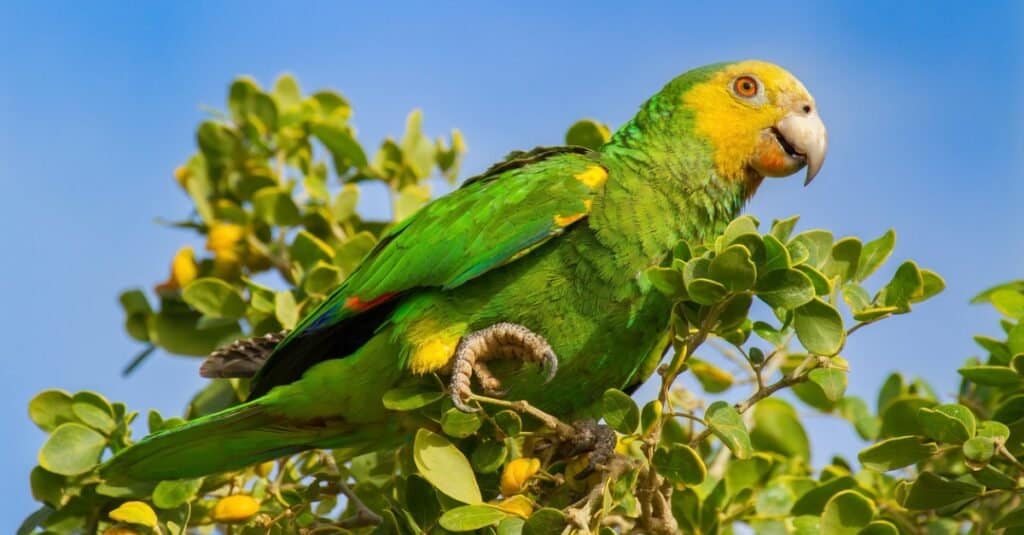
©iStock.com/Ben-Schonewille
Many kinds of parrots and parakeets have brilliant green feathers, and the 35 species of Amazon parrots are no exception. The green of the Amazon is often emphasized by areas of red, blue, yellow, purple, or maroon. The scaly-naped Amazon of the Andean cloud forest seems to sport the most green. Its body is bright grass green while its feathers are dark green but tinged with black. The yellow-headed Amazon of Central America and the Tres Marias Amazon found in Mexico’s Islas Marias islands have green bodies, yellow heads, and red epaulets on their wings. Mexico’s lilac-crowned amazon has a green body but a crown of violet-blue with a maroon-colored forehead. Some types of Amazon parrots are kept as pets.
2. Puerto Rican Tody
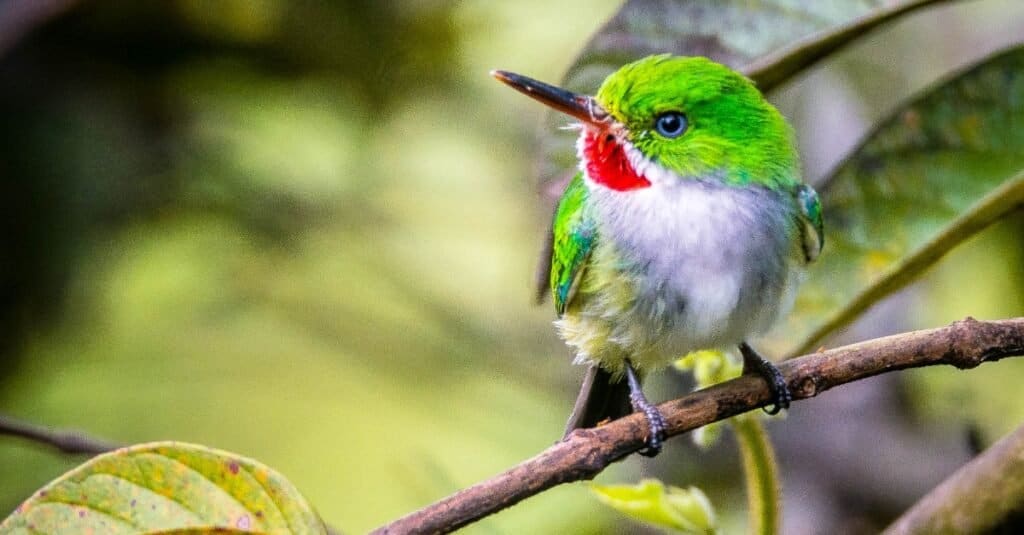
©iStock.com/VicBruno
This type of green bird is considered a non-passerine bird, which is weird because it is a little bird, only 4.3 inches long with a weight of about 18 ounces, and perches on trees. The Puerto Rican Tody is famous for its emerald green upperparts, though it has a white belly, yellow flanks, and a red throat. The lower beak is also red, and its bill can be longer than its head. Males and females can be told apart only from the color of their eyes. The eyes of the male are gray and the eyes of the female are white. The Jamaican Tody is similar, and some people believe that the two birds were separated when their ancestors were blown from one island to the other by hurricanes.
3. Green Broadbill
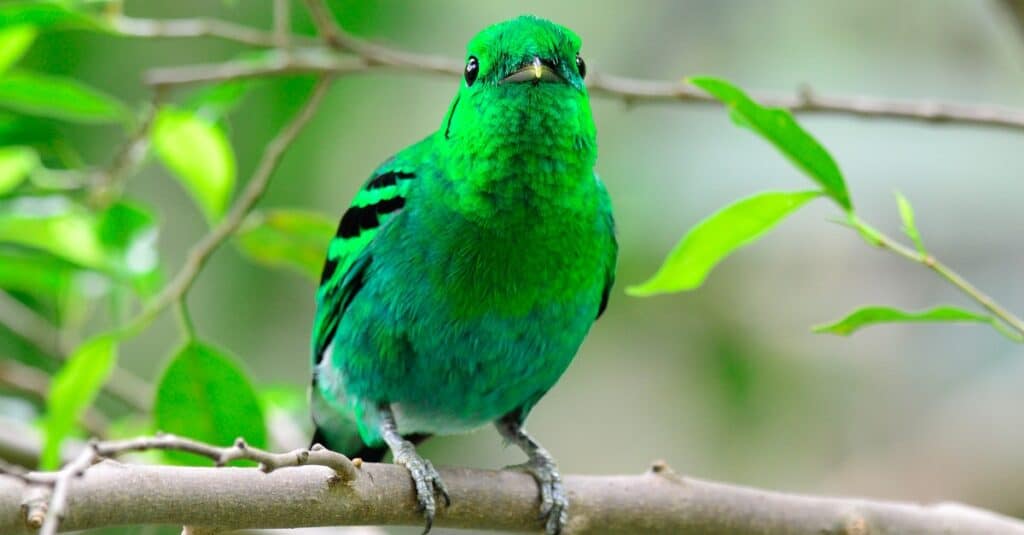
©iStock.com/PrinPrince
This type of little green bird of Sumatra and Borneo has a stubby tail and a crest at the front of its face that hides its tiny beak. Its plumage is rich, mossy emerald green, and it has contrasting black bands on its wings and a black patch over its ear. Its eyes are shiny black, round and beady. The Broadbill resembles a nightjar, for its small beak reveals an enormous mouth when it opens. Its green color allows it to nearly disappear into the evergreen forests where it lives. It eats figs and helps distribute the seeds. It will also take insects now and then. Unfortunately, the conservation status of the green broadbill is near threatened due to habitat loss.
4. Green Honeycreeper
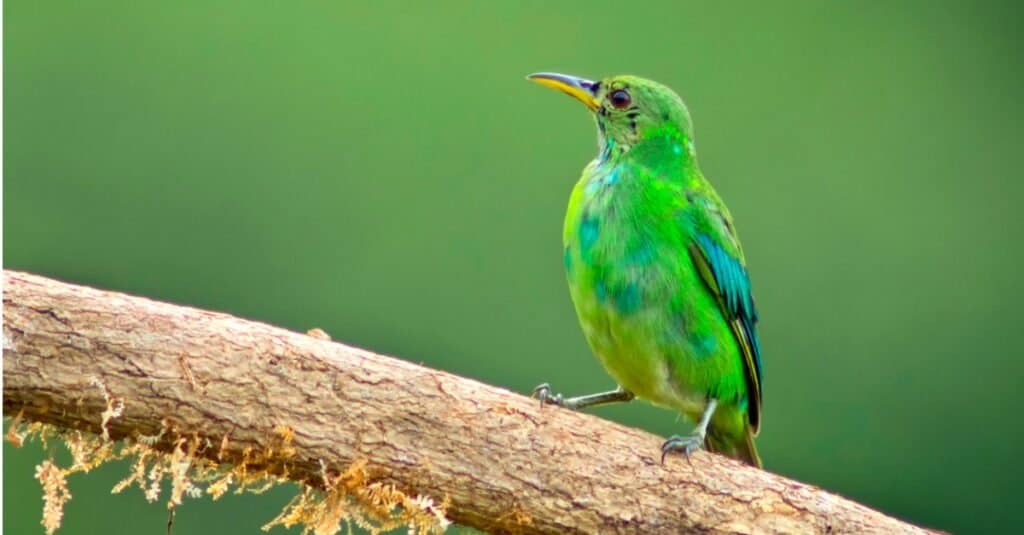
©iStock.com/Alberto Carrera
Both the male and female of this five-inch long tanager of Mexico, South America, and Trinidad are green, but they’re different shades of green. The green plumage of the male has an iridescent blue tinge, and he has a black face mask and a yellow lower beak. The female is green as grass, with a paler green throat. The bird’s bill is tapered and has a slight curve, which allows it to access nectar from inside flowers. It also eats berries and insects. The Green Honeycreeper is found in the canopy of the forest.
5. Hawai’i ʻAmakihi

©Stubblefield Photography/Shutterstock.com
Found on the Hawaiian islands, the green plumage of this little bird varies depending on the island. There are yellow-green birds on the big island, while birds that live on other islands tend toward olive-green plumage. Amakihi’s conservation status is of least concern, and biologists believe it’s because the bird is both hardy and very adaptable. This honeycreeper can live in many types of forests and elevations as high as 8,000 feet. It’s also known for its quiet but beautiful song.
6. Green Catbird
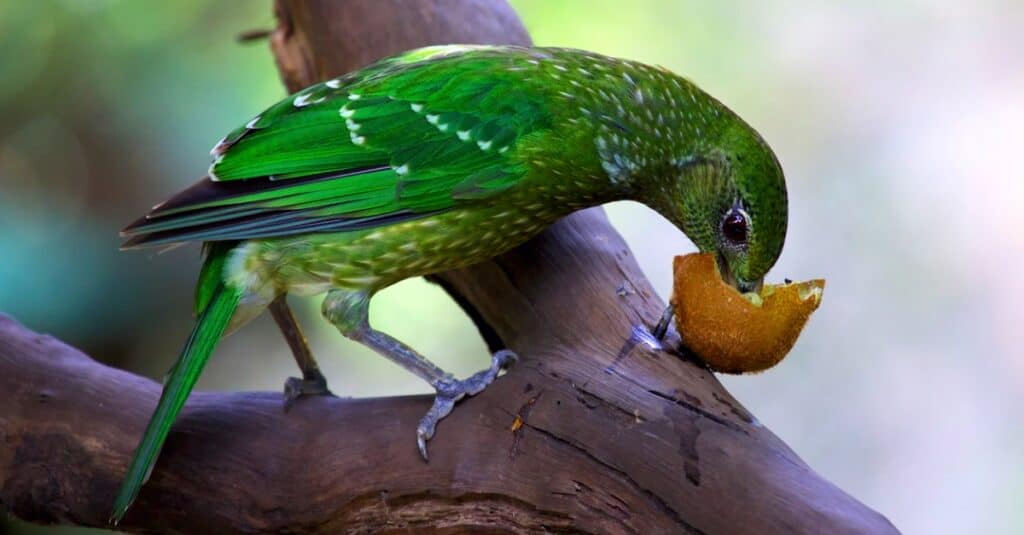
©iStock.com/hypergurl
Found in the rainforests of eastern Australia, this medium-sized bird has a heavy bill that helps it eat seeds, flowers, shoots, and buds as well as all kinds of insects and arthropods such as millipedes. Its topside is a lustrous emerald green, and it has white spots on its wings that form bars. There are also white spots on its breast. The head is a mottled olive green.
Both male and female birds have the same plumage, so it’s hard to tell them apart. The green catbird is a type of bowerbird, but the male doesn’t build a bower. Instead, he does a courtship dance and brings presents to a potential mate. Once he is chosen, the pair mates for life. The green catbird is also known for its call, which can be a bit eerie.
7. Superb Fruit Dove

©iStock.com/Ondrej Prosicky
The male of this dove sports olive green ears, back, wings, and tail with a gray breast, orange nape, a bit of sapphire blue at the throat, and a violet-red cap. The female is less spectacularly colored. Most of her feathers are green, and she has blue on the tops of her wing, light blue on her breast, and a white belly. Ironically, the male’s plumage helps it to hide among the sun-dappled trees of its home. As its name says, it eats fruit, including figs and the fruits of the New Guinea teak and Lilli Pilli’s.
8. Budgerigar
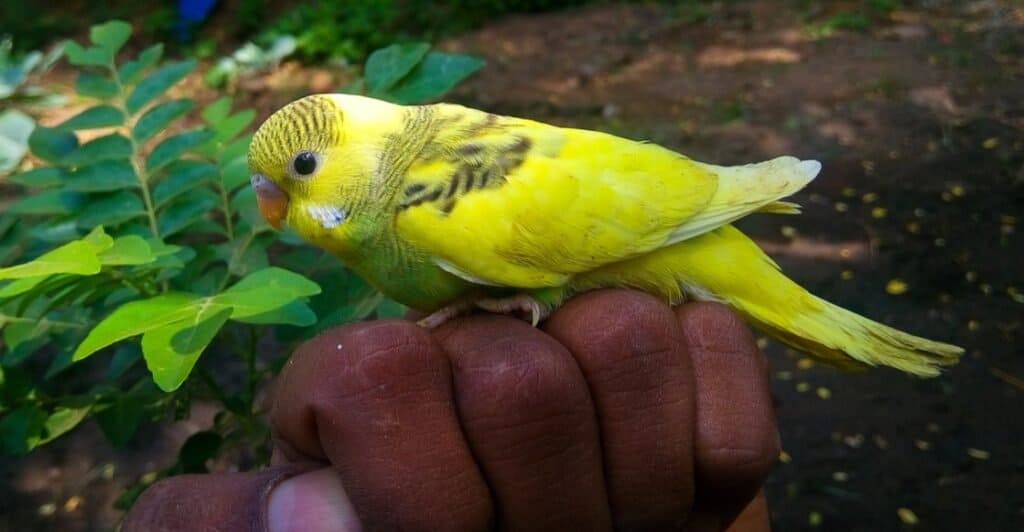
©ELAMARAN ELAA PHOTOGRAPHY/Shutterstock.com
Of all the different types of green birds the Budgerigar, or budgie, is one of the most popular. Called a parakeet in America, a wild budgerigar is a most vivid green. They’re native to most of Australia and can be spotted in huge nomadic flocks on the lookout for food. The body of this bird, which can grow to seven inches long, is bright light green, and they have black mottled mantles, yellow heads, and violet-blue cheek patches. Their long tails have dark blue feathers with streaks of yellow.
Domesticated budgerigars have been bred to be all sorts of colors. There are now white birds, bluebirds, lilac birds, gray birds, yellow-green birds, and birds that have been bred back to their ancestral green. Parakeets have proven to be delightful and easy to care for when kept as pets. You can tell males and females apart by that bit of flesh on top of their beak called a cere. The female is brown, and the male is blue.
9. Double-eyed Fig Parrot
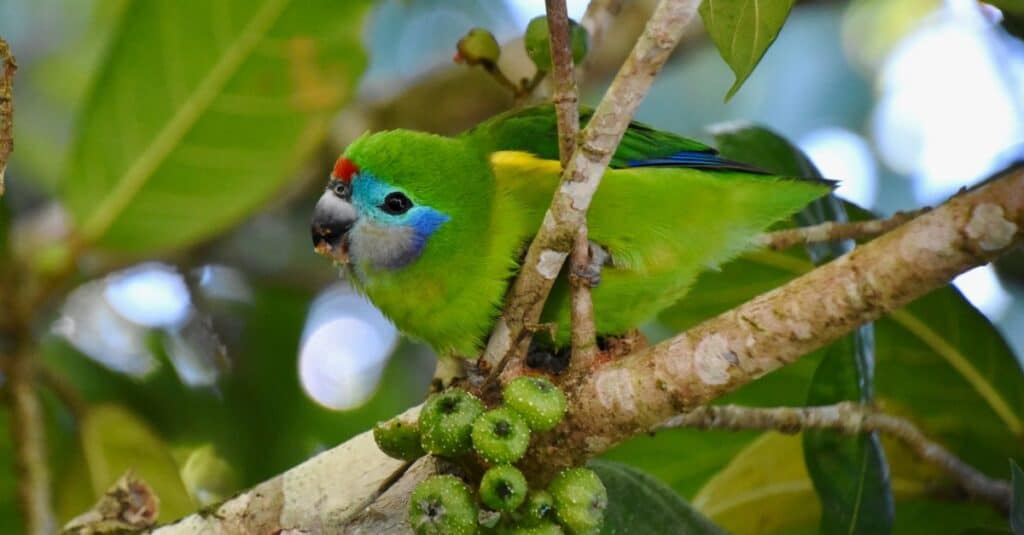
©iStock.com/Laura Howden
A little parrot native to New Guinea and parts of Australia, the male of this bird has a bright green body, a short tail, a huge head, and red and blue patches on its face. It gets its name because it has an eye-sized blue spot between its eye and its nostril. The female is less colorful and is mostly green all over. As the smallest parrot in Australia, a smaller event than a parakeet, it searches for berries, fruits, seeds, nectar, and grubs throughout the rainforest where it lives. There are eight species of double-eyed fig parrot, including the Astrolabe Mountain fig parrot and Hartert’s double-eyed fig parrot.
10. Pacific Parrotlet

©iStock.com/panupong1982
Pacific parrotlets are also kept as pets, but despite their small size of four to five inches in length, they’re aggressive towards other birds and need to be caged by themselves or with other Pacific parrotlets. In the wild, these birds have green bodies and green masks. Males have some blue on their wings, rumps, and blue behind their eyes that some describe as “eyeshadow.” Females, also green, do not have blue on their wings, but they can have eyeshadow and a blue rump. Domesticated Pacific parrotlets can be bred in a wealth of colors. These little birds are found near the coast of Ecuador and Peru and adapt well to human incursions.
Here is a Summary of 10 Types of Green Birds:
- Pacific Parrotlet
- Double-eyed fig parrot
- Budgerigar
- Superb Fruit Dove
- Green catbird
- Hawai’i ʻAmakihi
- Green Honeycreeper
- Green broadbill
- Puerto Rican Tody
- Amazon parrot
NEXT UP…
- Amazon Parrot Do you love parrots as much as we do? if so, you will enjoy these fun facts.
- Types of Tropical Birds There are so many types of tropical birds to talk about!
- 10 Incredible Bird Facts Some of these facts may surprise you.
The photo featured at the top of this post is © iStock.com/Laura Howden
Thank you for reading! Have some feedback for us? Contact the AZ Animals editorial team.






